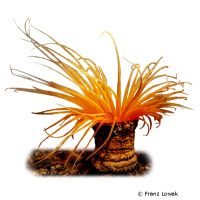Tube-dwelling Anemone (Pachycerianthus fimbriatus)
| Tube-dwelling Anemone Pachycerianthus fimbriatus | |
|---|---|
| Name | Tube-dwelling Anemone |
| Name Lat. | Pachycerianthus fimbriatus |
| Family | Cerianthid Anemones |
| Family lat. | Cerianthidae |
| Order | Tube-dwelling Anemones |
| Order lat. | Ceriantharia |
| Origin | Eastern Pacific |
| Diet | Carnivore |
| pH | 8.1-8.4 |
| Hardness | 8-12 °KH |
| Lighting | Low |
| Current | Moderate |
| Behavior | Semi-aggressive |
| Keeping | Individual |
| Care Level | Moderate |
| Life Span | N/A |
| Protection | No |
| Metric Units | |
| Size | 30 cm |
| Temperature | 15-20 °C |
| Salinity | 33-36 ‰ |
| Aquarium | 200 l |
| US Units | |
| Size | 12" |
| Temperature | 59-68 °F |
| Salinity | 1.020-1.025 sg |
| Aquarium | 50 gal |
Distribution and habitat
The range of Pachycerianthus fimbriatus extends along the American west coast from Baja California in Mexico to southern Alaska. They live solitarily in self-made tubes that they burrow and anchor in sandy or muddy soils. No colonies or sticks are formed. They are found at depths up to 50 m.
Maintenance
They require an aquarium with a sandy substrate about 10 cm deep in order to be able to burrow and should be positioned in a shady spot with a moderate, alternating current. The setup includes living stones, which act like a biological filter and with their porous structure provide settlement area and habitat for the purifying bacteria and microorganisms.
Only substrates rich in lime and free of heavy metals may be used as substrate. Filters, skimmers and heaters are necessary to ensure water quality, as well as pumps to simulate tides, swells and bottom currents. Lighting must match the species-appropriate day-night rhythm of the animals.
| Salinity: 33-36 ‰ | pH value: 8.1-8.4 |
| Carbonate hardness: 8-12 °KH | Nitrate content: 2-8 mg/l |
| calcium content: 420-450 mg/l | Nitrite content: 0.0-0.05 mg/l |
| Magnesium content: 1.250-1.350 mg/l | phosphate content: 0.01-0.1 mg/l |
Regular addition of trace elements, especially iodine, is recommended. For salinity, an average value should be aimed for, which may only vary slightly by +/- 0.5 ‰. Ammonia and ammonium must not be measurable. Special attention shall be paid to consistently good water quality and water values.
Diet
They do not possess zooxanthellae, so they require food that is collected from the water current. In doing so, the outer tentacle ring forms a catch basket that is aligned with the plankton current. In addition to the food produced in the aquarium during fish feeding (mysis, krill, Artemia, etc.), commercially available phyto- and zooplankton, liquid or frozen, should also be offered regularly. Regular and varied feeding promotes health and increases resistance.
Behaviour and compatibility
They are nocturnal and have very long, strongly nettling tentacles. Accordingly, a sufficiently large distance must be kept from each other and from other anemones and corals to avoid cnidation. Due to their strong nettling effect, sensitive fish, e.g. surgeonfish, can also suffer.
Reproduction and breeding
They are protandrous hermaphrodites, i.e. young animals are males that later become females. The sexual products are released into the open water where fertilization occurs. Development occurs through several planktonic larval stages
Important
They are bright orange to red and fluoresce under blue light (night light). The exact species identification of cylinder roses is difficult and only possible by examining the cnidocytes
Special care should be taken when inserting them. If possible, they should be placed with their living tube in a channel in the sand and covered with a thin layer of sand so that the tube protrudes only a few centimeters. They are semi-sessile and can change their position. When disturbed or in danger, they retreat into their living tube with lightning speed. The tentacles are sensitive to touch, strong light, and feeding with large pieces of food
A cooling unit is usually required for keeping them, as they cannot tolerate higher water temperatures on a permanent basis.
If different species are kept together, care should be taken to ensure that fish and invertebrates match each other in terms of water quality and temperature requirements, as well as their social behavior, and that the setup meets the ecological needs of all species kept together. Newly introduced animals must be acclimated slowly to the water in the aquarium. Further literature can be found in your pet store.
References
Text: Werner Winter; Image: Franz Lowak
Source: ERHARDT & BAENSCH (2000): Meerwasser Atlas Bd. 5, Mergus Verlag; ENGELMANN & LANGE (2011): Zootierhaltung - Tiere in menschlicher Obhut: Wirbellose, Verlag Harri Deutsch
